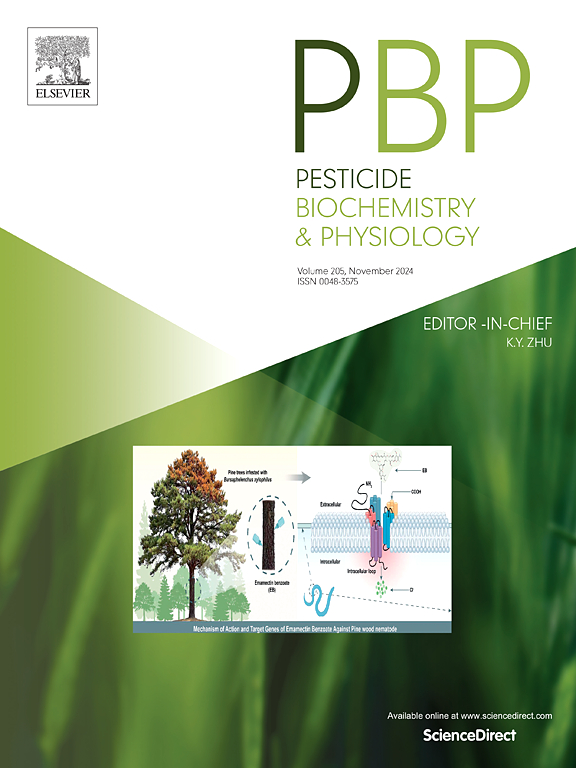RNAi-mediated knockdown of juvenile hormone acid methyltransferase depresses reproductive performance in female Aethina tumida
IF 4.2
1区 农林科学
Q2 BIOCHEMISTRY & MOLECULAR BIOLOGY
引用次数: 0
Abstract
Small hive beetles, Aethina tumide, are free-flying parasites of social bee colonies where they feed and reproduce. In case of mass infestation, A. tumida can cause significant economic losses. There is an urgent need to explore novel green molecular approaches for sustainable control of A. tumida. It has been confirmed that juvenile hormone acid methyl transferase (JHAMT) plays a crucial role in regulating the synthesis of juvenile hormone (JH). However, its impact on female reproduction of A. tumida remains unclear. In the present study, a novel JHAMT gene was identified from A. tumida with an open reading frame of 978 bp, encoding a polypeptide of 325 amino acids containing a Methyltransferase domain. The deduced amino acid sequence of AtJHAMT shared 60 % and 33 % identity with homologs from Brassicogethes aeneus and Apis mellifera, respectively. The expression profile indicates that the transcription level of AtJHAMT increases in the adult stages, reaching its peak in 5-day-old female adults. AtJHAMT exhibits the highest expression levels in the ovaries, and fluorescence in situ hybridization (FISH) demonstrates that this gene shows a significant number of positive signals in the ovarian ducts and the head region. Furthermore, we investigated the function of AtJHAMT through RNA interference and methoprene rescue experiments. We also investigeted the off-target effects of the dsJHAMT. The results showed that silencing AtJHAMT through oral dsRNA delivery (feeding dsRNA-SPc mix) affected ovarian development and significantly reduced JH titers, female fecundity, female fertility, and egg hatchability. The application of methoprene partially rescued the negative effect of silencing AtJHAMT on reproduction. Several genes associated with ovarian development were significantly downregulated following interference with AtJHAMT, but their expression levels were restored after complementation experiments. Additionally, the off-target effects experiment showed that dsJHAMT from A. tumida had no adverse effects on ovaries development in honey bee queens. Overall, this study illustrates the functions of the JHAMT in A. tumida, which can serve as a potential target for controlling the reproduction of the most deleterious bee parasites, A. tumida.

rnai介导的幼崽激素酸甲基转移酶的下调抑制了雌性肿眼蝶的生殖性能
小型蜂房甲虫是群居蜂群中自由飞行的寄生虫,它们在那里觅食和繁殖。在大规模侵染的情况下,tumida会造成重大的经济损失。目前迫切需要探索新的绿色分子方法来实现对野田螺的可持续控制。幼鱼激素酸甲基转移酶(JHAMT)在调节幼鱼激素(JH)的合成中起着至关重要的作用。然而,其对棉铃虫雌性繁殖的影响尚不清楚。在本研究中,从a . tumida中鉴定出一个新的JHAMT基因,该基因具有978 bp的开放阅读框,编码含有甲基转移酶结构域的325个氨基酸的多肽。推导出的AtJHAMT氨基酸序列与芸苔属和蜜蜂同源物的同源性分别为60%和33%。表达谱显示,AtJHAMT的转录水平在成虫阶段逐渐升高,在5日龄雌成虫时达到峰值。AtJHAMT在卵巢中表现出最高的表达水平,荧光原位杂交(FISH)表明该基因在卵巢导管和头部区域显示出大量的阳性信号。此外,我们还通过RNA干扰和甲氧丁二烯拯救实验研究了AtJHAMT的功能。我们还研究了dsJHAMT的脱靶效应。结果表明,通过口服dsRNA(喂食dsRNA- spc混合物)沉默AtJHAMT会影响卵巢发育,显著降低JH滴度、雌性繁殖力、雌性繁殖力和卵子孵化率。甲基戊二烯的应用部分挽救了沉默AtJHAMT对生殖的负面影响。在干扰AtJHAMT后,一些与卵巢发育相关的基因显著下调,但在互补实验后,它们的表达水平恢复。此外,脱靶效应实验表明,来自tumida的dsJHAMT对蜂王卵巢发育无不良影响。总的来说,本研究阐明了JHAMT在蜜蜂中的功能,它可以作为控制最有害的蜜蜂寄生虫——蜜蜂的繁殖的潜在靶点。
本文章由计算机程序翻译,如有差异,请以英文原文为准。
求助全文
约1分钟内获得全文
求助全文
来源期刊
CiteScore
7.00
自引率
8.50%
发文量
238
审稿时长
4.2 months
期刊介绍:
Pesticide Biochemistry and Physiology publishes original scientific articles pertaining to the mode of action of plant protection agents such as insecticides, fungicides, herbicides, and similar compounds, including nonlethal pest control agents, biosynthesis of pheromones, hormones, and plant resistance agents. Manuscripts may include a biochemical, physiological, or molecular study for an understanding of comparative toxicology or selective toxicity of both target and nontarget organisms. Particular interest will be given to studies on the molecular biology of pest control, toxicology, and pesticide resistance.
Research Areas Emphasized Include the Biochemistry and Physiology of:
• Comparative toxicity
• Mode of action
• Pathophysiology
• Plant growth regulators
• Resistance
• Other effects of pesticides on both parasites and hosts.

 求助内容:
求助内容: 应助结果提醒方式:
应助结果提醒方式:


